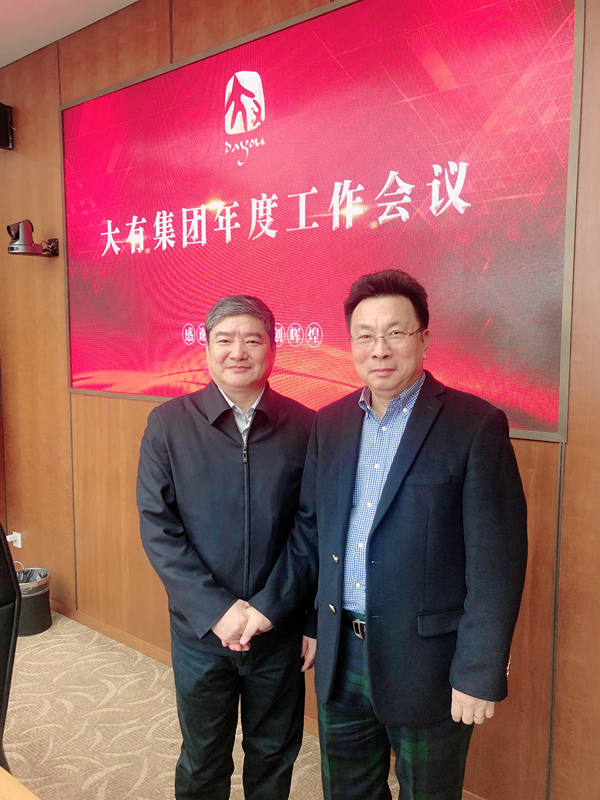
Dayou Group holds 2018 year-end summary and 2019 development plan meeting
2019-01-21
Recently, our group held the 2018 year-end summary and 2019 development plan meeting. The group stood at the height of reform and opening up to think about the work content, relying on the party's leadership, open and inclusive innovation, and aiming at the national strategy to build a great platform. The meeting pointed out that in the past year, the average investment of major enterprises in the IoT infrastructure was about 4.6 million US dollars, an increase of 4% over 2017. About 84% of enterprises hope to complete the deployment of the Internet of Things in 2021. The Internet of Things will reach a mature stage of development in the next two years and begin to make a significant contribution to the business model.
There are also industry companies predicting that in just two years, almost 1.5 GB of data will be generated per person per day on Earth. This will drive spending on IoT systems and services from less than $500 in 2013 to $1.7 trillion in 2019. It is estimated that by 2022 only marginal infrastructure spending will exceed $6.7 billion. Edge technologies include countless categories and subcategories, all of which should be used for a variety of use cases – from smart appliances to smart cars to the entire smart city. However, if this technical foundation has an overall theme, then its core will be to find ways to process large amounts of data in the most efficient and efficient way.
In this work, not just the Internet of Things, but almost all data infrastructure will use artificial intelligence. Tools such as machine learning, neural networks and autonomous analytics, and other applications are expected to provide data to the right place, and analysis in the right scenarios and insights to the right people is invaluable. At the same time, the edge of the intelligent system must decide for itself which data to process locally and which data should be used for centralized facilities. Most edge computing facilities consist of micro data centers that can quickly deliver results to connected devices, not only to respond quickly, but also to prevent centralized computing, storage, and network resources from overwhelming applications. To this end, edge computing requires not only automation, but also a high degree of autonomy, where the machine can decide how to operate in various situations.

According to industry forecasts, the transition from smart edges to smart grids will be more flexible and responsive, even as IoT workloads and systems become more complex. In this way, the Internet of Things will facilitate greater connectivity between edge resources and even endpoint devices, replacing today's point-to-point solutions with new multipoint-to-multipoint fabric layers. This will drive knowledge workers' need for new skills. For example, once the network has the ability to self-configure and manage, traditional managerial responsibilities will gradually disappear, and more strategic roles will gain a higher status. The lack of skilled professionals who can oversee the artificial intelligence-driven process is now a major issue as most organizations expect a 90% success rate for implementing artificial intelligence on the IoT infrastructure over the next two years.
The conference study pointed out that although artificial intelligence technology is considered to operate entirely on its own without human supervision, if no skilled data scientist tells it what to do, almost no intelligent solution can operate normally. This means that future IoT-oriented companies will face these three options: retain existing IT staff to understand the complexity of data science, outsource smart operations to professional providers, or begin to experiment directly with open source models. Open source technology is critical for edge computing, and it requires extensive collaboration across systems and platforms. Most of the current situation is implemented through organizations such as IEEE, OCP and Telecommunications Infrastructure Project (TIP). Over time, a more comprehensive solution will emerge in the future. The Internet of Things will continue to evolve in various functions such as security and governance.
In 2019, our group should do a good job in party building, do a good job in technological innovation and industrial chain, build a good alliance and financial platform, set up an industry industry poverty alleviation fund, and contribute to the great rejuvenation of the Chinese nation, and work in the coming year. The focus will be on pushing the current behind-the-scenes operations to the forefront of the digital economy. Once the Internet of Things becomes a source of services and revenue, it is not just an extension of traditional infrastructure, it also ensures that people live in a truly connected and secure world.
